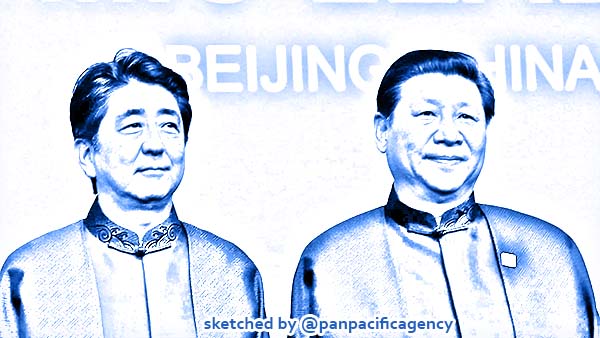[Analytics] Can a Xi charm offensive win over Japan?

Japanese Prime Minister Shinzo Abe, left, and Chinese President Xi Jinping attend an Asia-Pacific Economic Cooperation summit in Beijing in 2014 © Reuters. Sketched by the Pan Pacific Agency.
Amid Japan’s rising tensions with the United States, Chinese President Xi Jinping has been reaching out to Japan, sending masks, ventilators and other medical supplies. Chinese leaders are trying to improve public opinion in order to put the bilateral relationship on solid footing, launching a political campaign centred on the slogan ‘neighbour-to-neighbour help’. Rumi Aoyama specially for the East Asia Forum.
This effort has even extended down to a local Chinese television network, Shanxi TV, abruptly stopping the broadcasting of an anti-Japanese drama Red Sorghum (Hong Gaoliang) mid-series.
So far, Xi’s endeavour has improved Japan’s image in China but has borne little fruit in Japan. Rather, his national agenda of ‘resolutely defending China’s sovereignty’ has soured bilateral ties, both politically and economically.
Tensions continue to mount over the disputed Senkaku/Diaoyu Islands. In June, the Ishigaki Municipal Assembly passed a bill renaming the section of the ‘Tonoshiro’ administrative area covering the islands to ‘Tonoshiro Senkaku’. China is also stepping up activities in the contested waters. Since 14 April, China Coast Guard vessels have operated daily in the contiguous zone, marking a new record for the number of consecutive days in the zone. In July, Japan lodged a protest with China against vessels encroaching on territorial waters near the Senkakus for more than 39 hours, the longest such individual incursion event since Japan nationalised the islands in 2012.
Tensions are also building over Okinotori Island, which Japan claims as its southernmost territory. The Abe administration filed protests after Chinese ships were spotted conducting research in the exclusive economic zone (EEZ) near the island. A Chinese Ministry of Foreign Affairs spokesperson rebutted that Okinotori does not generate maritime entitlement to an EEZ because it is only rocks, not an island.
Japanese lawmakers and policymakers have sounded the alarm about Japan’s deteriorating security environment. In recent years, Chinese carrier-based fighters and aircraft carriers have frequently traversed the Miyako Strait in Japan’s south. In April, security concerns were heightened when the Chinese aircraft carrier Liaoning and five guided-missile destroyers and frigates sailed across the strait to the Pacific. Japan’s annual white paper The Defense of Japan 2020, released in July, explicitly highlighted ‘the emergence of security challenges’ in a region where ‘military powers with high quality and quantity are concentrated’.
This growing sense of unease led to a resolution calling for the cancellation of President Xi’s state visit to Japan by two foreign affairs-related parliamentary committees within the ruling Liberal Democratic Party (LDP). The resolution came just days after China’s National People’s Congress enacted the national security law in Hong Kong.
LDP Secretary General Toshihiro Nikai, a leading pro-china politician, has urged the groups to drop the resolution or change the wording for fear that it will worsen the already-fragile relationship. But the resolution was passed in the committees and submitted to the Chief Cabinet Secretary. While the resolution is merely symbolic, this conflict within the LDP is indicative of a growing political trend in Japan — more politicians are beginning to challenge Chinese actions in order to defend Japan’s national interests and democratic values.
Economic ties, which have served as ballast amid political tensions, are beginning to unravel. In an effort to encourage Japanese companies to diversify global value chains and relocate their production bases back to Japan or in Southeast Asia, the Abe administration decided on 17 July to grant subsidies to 87 companies. Most are small and medium-sized enterprises, though the list includes some large medical and semiconductor-related companies. The process of decoupling strategic reserves is underway, though moving at a languid pace.
Japan is at a crossroads of structural change. The LDP recently approved a proposal by its national security panel. Avoiding the controversial phrase ‘the ability to attack enemy bases’, it states that Japan needs to be able to intercept ballistic missiles even on the territory of other countries. While the proposal has been harshly criticised for violating Japan’s long-term exclusively defence-oriented security policy, it has also gained support from lawmakers and a number of prominent academics.
Faced with growing security threats from China and North Korea, Japan has also become increasingly concerned about the integrity of the US commitment to Japan’s defence. In this environment, many advocates argue that Japan needs to increase its military build-up and be prepared to go it alone, the first step being the acquisition of deterrence capabilities.
Though still under discussion, such capabilities would represent a dramatic shift from Japan’s exclusively defence-oriented security policy and have significant implications for the military balance in Northeast Asia. For the past 70 years, Japan has been viewed as the ‘shield’ and the United States the ‘spear’. This move from the Abe administration has the potential to change the nature of the Japan–US alliance — Japan will no longer be just a shield should it gain strike capabilities.
US President Donald Trump’s policies toward China have brought China closer to Japan, while Japan’s anxiety about the credibility of the US alliance has encouraged Japan to beef up its own military capabilities and carefully consider relations with China. But China’s mixed signals may still ultimately drive Japan away.
Rumi Aoyama is Professor at the Graduate School of Asia-Pacific Studies, Waseda University.